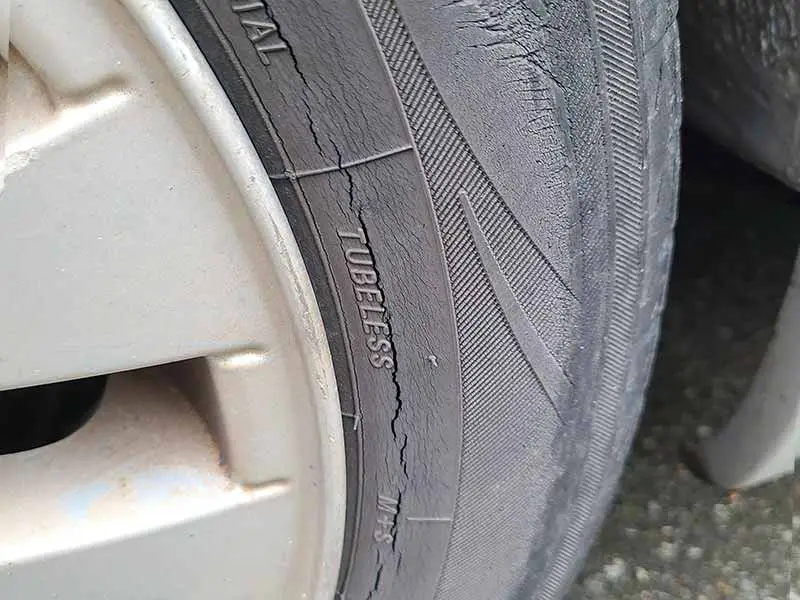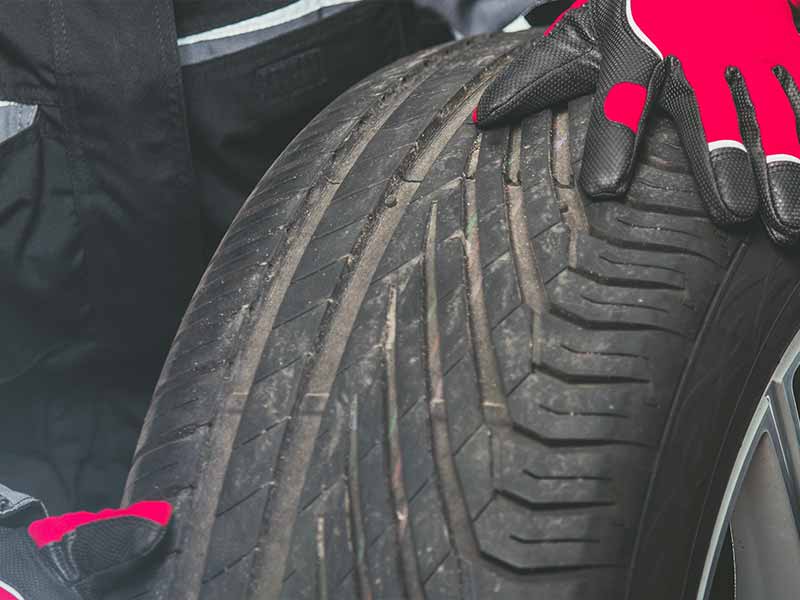Normal wear patterns vary slightly from one vehicle to the next, but tire wear is usually smooth across the width and around the tire tread. To maintain good tire wear and longer tire life, you need to practice safe driving and maintain your tires regularly.
Normal Tire Wear
The average car with typical good quality all-season tires will last 50,000-60,000 miles and wear fairly evenly across the entire width of the tire tread.
Different tires and different vehicles will wear tires differently, but this is generally what you can expect from a typical sedan on the most popular type of tire.
Traction and safety are the results of properly maintaining your tires. It’s not terribly time-consuming or expensive to perform these tasks.
Let’s take a closer look.
How Long Should Tires Last?
When you buy a new pair of tires, you likely want to predict how long they’ll last. Tires aren’t cheap, so this is a logical question. To answer this question, we can break it down into a few subcategories: how long they’ll last in miles, and years, and how to predict how long they’ll last.
Average Tire Life in Miles
First up, we’ll discuss tire life in terms of miles. In other words, looking at how many miles can you drive a car with the same set of tires.
The average tire will last 50,000 to 60,000 miles on most vehicles for most drivers. This is for typical conservative driving habits with common sedans, trucks, or SUVs.
Many factors affect tire life, such as driving style, vehicle type, and ensuring the tires are properly maintained.
Some tires, such as high-performance tires, use softer rubber compounds and will only last 35,000 or so. Other tires may be capable of achieving 70,000 or 80,000 miles.
The best way to know how many miles the tires you have on your car or truck will likely last for you is to check the tire warranty mileage guarantee that comes with most tires.
Average Tire Life in Years
Now, let’s think about your tire life in terms of years. As we mentioned, a typical all-season tire will last about 50,000-60,000 miles before it needs to be replaced.
The average driver will drive around 12,000 miles each year. As a result, your tires will start to degrade after 4 to 5 years of continued use.
If you don’t drive as often, your tires will still break down. Tires will start to dry rot after 6 years, whether they’re used or not, simply due to how rubber acts as a material.
Tires stored properly in a temperature-controlled environment with tires sealed in airtight bags and kept away from sources of ozone and ultraviolet rays can last longer than 6 years.
It is still suggested that you discard any tire older than 10 years of age. If stored aren’t showing sides of dry rot, they should be safe to use up to the 10-year maximum.

How To Check the Age of a Tire
If you’re not sure when you put on your tires, there’s some good news. Most tire manufacturers add a date code to trace their batches and tell you when the tire was made. Remember, the timer starts as soon as the tire is made — after 6 years, the rubber starts to break down and dry rot.
If you look at the side of your tire, you should see text that says “DOT” followed by a series of numbers and letters. Focus on the final four numbers of the series, this is the manufacture date.
Within these four digits, the first two digits tell you the week number, and the last two digits tell you the year number. If you see 2921 that means that the tire was made on the 29th week of the 2021st year.
Common Tire Wear Patterns
Once your tires start to wear from use, there are a few different patterns to look out for. Your tires should wear fairly evenly across the tire tread. Spotting uneven tire wear patterns early can allow you to correct the issue and prevent you from needing to replace your tires before you’ve been able to get all of the value out of them.
Once uneven tire wear begins, it shortens the usable life of your tires. Catching these problems early will save you money and ensure your tires are gripping the road surface properly.
- Inner shoulder wear. This is when an area around the circumference of your tire is worn more than the rest of your tire. In this case, it’s on the side of the tire that’s closest to your vehicle. Inner shoulders of tires become worn due to camber wear or toe wear due to alignment problems.
- Outer shoulder wear. This is the same condition as inner shoulder wear, but the wear is on the side further from your vehicle. It’s also a result of poor alignment due to camber wear or incorrect toe. Aggressive driving is also a common cause of outer wear on the front tires.
- Both shoulder wear. If both the inner and outer edges of your tires are worn more than the center of your tire tread, the problem is underinflation. Alignment problems and driving style can make one inner or outer edge wear more than another, but not having the proper inflation pressure for the tire is almost certainly the main problem.
- Center wear. For tires with more wear along the middle, that’s called center wear. This is when the inner or outer edges have less tire tread wear than the center. In this case, your tire might be overinflated which bulges the center out enough to reduce wear at the edges.
- Cupping. Cupping looks like diagonal strips of uneven tire wear. Typically, you’ll notice it evenly spread along the full circumference. This pattern is due to your tire bouncing from poor alignment, failing shocks, poor tire quality, or even a damaged tire or bent rim.
- Feathering. Feathering makes your tire look like a saw blade from a front-on view. This sawtooth pattern goes from one sidewall to the other, and it’s a noticeable pattern. It’s caused by poor alignment.
- Heel and toe wear. Another form of wear is heel and toe wear. In this case, a saw tooth pattern goes around the tire along the circumference. If you look at the tire from the side you will see the sawtooth angle of the tread blocks. This uneven wear is also caused by improper alignment, specifically the toe alignment.
- Patch wear. Patch wear is a series of flat spots on your tire. It’s inconsistent and doesn’t follow a pattern, unlike other forms of tire wear. It can be due to damage, improper balance, or a bent rim.
Proper Tire Care Tips
The best way to keep your tires lasting longer is to take care of them. In this section, let’s find out the best ways to take care of your tires.

Portable Tire Inflator With Digital Gauge
Tire Pressure – Monthly
Arguably the most important tip when it comes to proper tire care is monitoring your tire pressure. While it might not seem like a big deal, your tire pressure determines things like:
- How fast you can take a corner
- How quickly you accelerate
- How long it takes you to stop
- How your tires wear
- Total gas mileage
- Overall performance
Being off by just a few psi can make your car unsafe to drive.
Check the door jam of your car to see what pressure the manufacturer suggests that you keep your tires at. To check your tire pressure, use a pressure gauge and connect it to your tire’s valve stem. The gauge will indicate the current tire pressure, so you should adjust it accordingly to hit the figures on your door jam.

Temperature fluctuation and tire damage can change your tire pressure, so it’s suggested that you check it every month.
I should note that while many people think that the tire pressure monitoring system is there to let you know when to put air in your tires, it only does so when the tire pressure drops below 25% of recommended. This is why checking for proper tire pressure regularly is important for long tire life.
Wheel Alignment – 10,000 Miles
Another major player in overall tire health is the alignment of your wheels. This refers to how straight, square, and parallel the tires are compared to one another and your car as a whole.
The adjustments that help ensure your tires grip the road properly and wear evenly are camber, caster, and toe. Each vehicle manufacturer will have unique specifications for each of these adjustments that must be checked.
Improper alignment is the cause of a slew of unusual wear patterns and if not caught early, will dramatically shorten the life of your tires.
You should have your wheel alignment checked every 10,000 miles or hit a nasty pothole.
Tread Depth – Monthly
When the treads on your tires wear out, they become less effective. Your performance will suffer and your stopping distance will increase.
Experts typically suggest replacing your tires when the tire tread is less than 4/32 of an inch it is legally required in most states once the tire wear has reached 2/32″.
The tread depth is the distance from the top of the rubber tire tread to the base or the overall height of one piece of tread on your tire.
Tread depth can be checked with a visual inspection of the wear bars, the use of the penny test, or a tread depth gauge.

Quality Dial Tread Depth Gauge
Tire Balance – 10,000 Miles
The balance of your tire refers to how the weight is distributed. Since tires are circular and spinning, the weight needs to be perfectly balanced around your tire.
Tire balancing entails adding weight to spots around your tire to ensure it’s perfectly balanced. This needs to be done any time new tires are installed or if you notice steering wheel vibration, uneven tire wear, or excessive shaking over 60 mph.
It is difficult to eliminate steering wheel vibration at speeds over 60 mph. Minor vibrations are normal. For the best tire balancing results, use a tire shop with a road force balancer.
Tire Rotation – 5,000 Miles
A rotation of your tires will keep the wear even across your vehicle. We suggest rotating your tires every 5,000 miles. Doing so will help your tires last longer, increase safety, and reduce any road noise while you drive.
Tire rotation is also often a requirement to maintain the tire manufacturer’s tire warranty and rotating your tires every 5,000 miles will usually meet or exceed their minimum rotation interval.
If you never rotate your tires, there’s a good chance that at least one tire will start to wear unevenly. This will cause you to prematurely replace all four tires, wasting your money, and jeopardizing your safety while driving due to reduced grip.
Resources
Below are some links you may find helpful when learning about tires
Final Thoughts
Keeping tire wear patterns normal and tread depth even requires good maintenance practices from the moment you get your new tires.
Taking a moment once a month to check tire tread wear and tire pressure regularly will go a long way to avoiding uneven tire wear patterns and shortened tire life.
Good luck and happy motoring.







